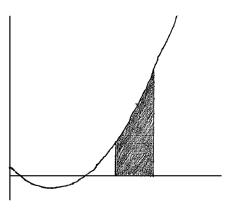| Date | November 2011 | Marks available | 4 | Reference code | 11N.2.sl.TZ0.7 |
| Level | SL only | Paper | 2 | Time zone | TZ0 |
| Command term | Find | Question number | 7 | Adapted from | N/A |
Question
Let \(f(t) = 2{t^2} + 7\) , where \(t > 0\) . The function v is obtained when the graph of f is transformed by
a stretch by a scale factor of \(\frac{1}{3}\) parallel to the y-axis,
followed by a translation by the vector \(\left( {\begin{array}{*{20}{c}}
2\\
{ - 4}
\end{array}} \right)\) .
Find \(v(t)\) , giving your answer in the form \(a{(t - b)^2} + c\) .
A particle moves along a straight line so that its velocity in ms−1 , at time t seconds, is given by v . Find the distance the particle travels between \(t = 5.0\) and \(t = 6.8\) .
Markscheme
applies vertical stretch parallel to the y-axis factor of \(\frac{1}{3}\) (M1)
e.g. multiply by \(\frac{1}{3}\) , \(\frac{1}{3}f(t)\) , \(\frac{1}{3} \times 2\)
applies horizontal shift 2 units to the right (M1)
e.g. \(f(t - 2)\) , \(t - 2\)
applies a vertical shift 4 units down (M1)
e.g. subtracting 4, \(f(t) - 4\) , \(\frac{7}{3} - 4\)
\(v(t) = \frac{2}{3}{(t - 2)^2} - \frac{5}{3}\) A1 N4
[4 marks]
recognizing that distance travelled is area under the curve M1
e.g. \(\int {v,\frac{2}{9}} {(t - 2)^3} - \frac{5}{3}t\) , sketch

distance = 15.576 (accept 15.6) A2 N2
[3 marks]
Examiners report
While a number of candidates had an understanding of each transformation, most had difficulty applying them in the correct order, and few obtained the completely correct answer in part (a). Many earned method marks for discerning three distinct transformations. Few candidates knew to integrate to find the distance travelled. Many instead substituted time values into the velocity function or its derivative and subtracted. A number of those who did recognize the need for integration attempted an analytic approach rather than using the GDC, which often proved unsuccessful.
While a number of candidates had an understanding of each transformation, most had difficulty applying them in the correct order, and few obtained the completely correct answer in part (a). Many earned method marks for discerning three distinct transformations. Few candidates knew to integrate to find the distance travelled. Many instead substituted time values into the velocity function or its derivative and subtracted. A number of those who did recognize the need for integration attempted an analytic approach rather than using the GDC, which often proved unsuccessful.

